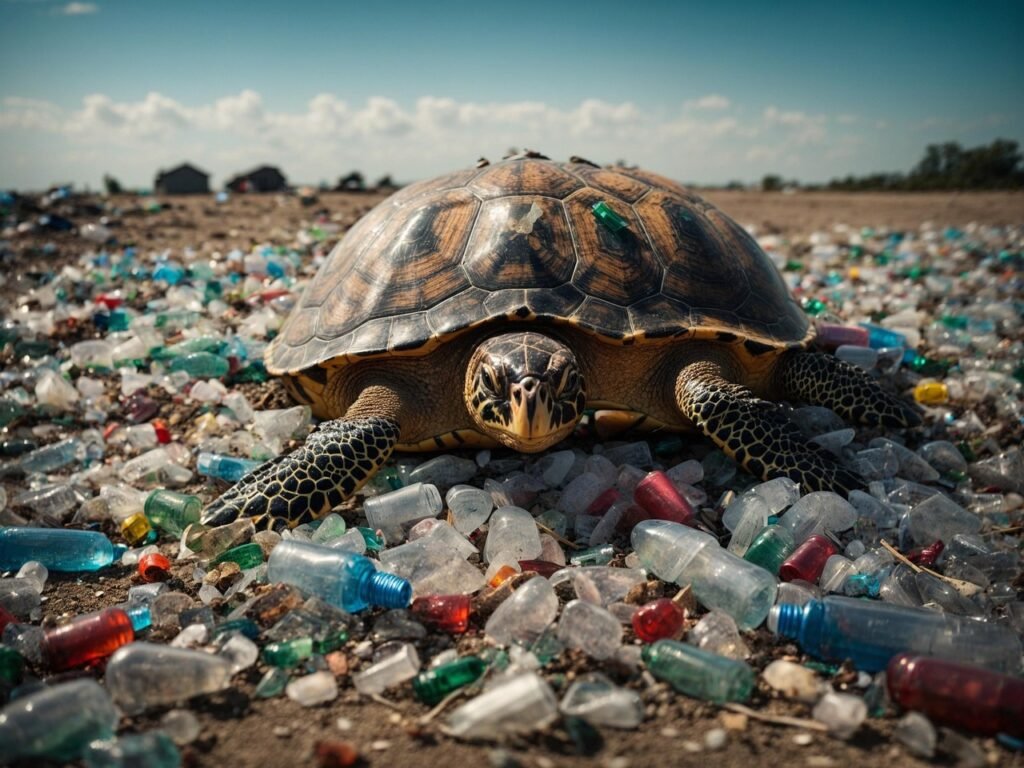Take a look around you. Chances are there’s plastic within arm’s reach. It could be your phone case, a pen, your grocery bag, a water bottle, or even the chair you’re sitting on.
It could be in the form of packaging, synthetic fabric, disposable utensils, or that takeaway cup from this morning.
And while plastic has become an inseparable part of our lives, thanks to how cheap, versatile, and lightweight it is, it’s also causing far more environmental damage than most of us realize.
What began as a brilliant invention to improve convenience and industrial progress has morphed into one of the planet’s most pressing problems.
Here are 15 shocking plastic pollution stats that might just make you rethink the way we use this seemingly harmless material:
1. Plastic is Only 118 Years Old — But Look at the Damage Already!
It all started in 1907, when Belgian chemist Leo Baekeland developed the first fully synthetic plastic, a material called Bakelite. Baekeland’s invention opened doors for a wave of innovation. Soon, plastic became integral to everything from household items and electronics to medicine and aviation.
But here’s the kicker: in just over a century, plastic has gone from being a revolutionary material to a symbol of pollution and excess. Its youth compared to other materials makes its overwhelming impact even more alarming.
2. We Produce Over 400 Million Metric Tons of Plastic Waste Every Year
Let that sink in; over 400 million metric tons of plastic are produced annually. That’s more than the weight of all humans on Earth combined .
And this number is rising rapidly. If nothing changes, plastic production is expected to double by 2050.
This massive volume is driven largely by single-use items, packaging, and consumer goods—all contributing to a waste crisis spiraling out of control.
3. Only 9% of All Plastic Ever Made Has Been Recycled
Despite growing awareness and efforts to recycle, the global recycling rate for plastic remains pitifully low—just 9%. The rest is either burned, dumped in landfills, or ends up leaking into the environment.

One reason for this low number is that not all plastics are recyclable. Different resins, contamination, and inefficient systems make it nearly impossible to close the loop on plastic use.
4. Plastic Never Truly Decomposes
Here’s a chilling thought: every piece of plastic ever made still exists in some form. Unlike organic materials, plastic does not biodegrade. Instead, it breaks into smaller fragments called microplastics, which can linger in the environment for hundreds or even thousands of years.
From Arctic ice to Mount Everest to your tap water, microplastics have infiltrated every corner of the Earth. They’re invisible to the naked eye, but they’re everywhere.
5. Humans Ingest a Credit Card’s Worth of Microplastics Every Week
Yes, you’re eating plastic, whether you know it or not. Research shows that the average person consumes about 2,000 microscopic plastic particles per week, which weighs around 5 grams; the same as a credit card.
That’s 260 grams a year, or roughly the weight of a medium-sized apple. These microplastics come from bottled water, seafood, table salt, and even the air we breathe.
6. The Majority of Plastic in the Ocean Is Made of Tiny Pieces Less Than 1 cm
When you imagine ocean pollution, you might picture plastic bottles or grocery bags. But most of the plastic in our oceans is actually in the form of microplastics. Yes, those tiny fragments under 1 cm in size are the most dominant in our waters, with an average mass equivalent to 1/10 of a paper clip.
These fragments are small but deadly. They’re easily mistaken for food and ingested by marine organisms and can carry toxic chemicals up the food chain—right back to us.
7. A Truckload of Plastic Enters the Ocean Every 60 Seconds
That’s right—every 60 seconds that tick away, one garbage truck full of plastic is dumped into our oceans. That adds up to over 8 million tons per year.
This relentless influx of plastic is choking marine ecosystems and turning once-pristine waters into plastic soup. If trends continue, the ocean could contain more plastic than fish (by weight) by 2050.
8. 81 Out of 123 Marine Mammal Species Are Impacted by Plastic
From majestic whales to playful dolphins, 81 out of 123 marine mammal species have been found to have either ingested plastic or become entangled in it. Ingesting plastic can block digestive tracts, cause internal injuries, and lead to starvation.
Worse still, all seven species of sea turtles are also affected by plastic pollution. Floating bags can look eerily like jellyfish, one of their favorite foods—with deadly consequences.
9. 300,000 Whales, Dolphins, and Porpoises Die Every Year Due to Abandoned Fishing Gear
Ghost gear—fishing lines, nets, and traps that are discarded or lost at sea—accounts for a large share of marine plastic pollution. An estimated 300,000 whales, dolphins, and porpoises die each year after becoming entangled in this debris.

These creatures often suffer slow and painful deaths, either by drowning, suffocation, or severe injuries caused by tight entanglement.
10. Plastic Waste Has Doubled in the Past 20 Years
In just two decades, the world’s plastic waste has doubled. More plastic is being used, and more of it is being discarded irresponsibly. Most of it ends up in landfills, incinerators, or leaked into nature.
This rapid acceleration shows that our consumption patterns are worsening, not improving—and time is running out to reverse the trend.
11. More Than Half of All Plastic Is Single-Use
Over 50% of plastic produced globally is designed to be used once and thrown away. These include items like straws, cutlery, wrappers, and packaging.
What’s worse? These products often require significant energy and resources to produce, only to be used for mere minutes before becoming permanent pollution.
12. The Average Plastic Bag Is Used for Just 12 Minutes
Think about that. A plastic bag, usually made from fossil fuels, manufactured in an energy-intensive process, typically gets used for just 12 minutes before being thrown away.
Yet it can take up to 1,000 years to decompose. That’s one of the most mind-boggling imbalances in our entire economy.
13. More Than 35% of Plastic Goes Into Packaging
Of all plastic produced globally, more than 35% is used just for packaging. That includes wrapping for snacks, bottles, boxes, and bubble wrap.
Most of this packaging is non-recyclable and ends up in landfills or as litter shortly after use. Reducing packaging waste is one of the most actionable steps companies and individuals can take.
14. An Average Person Uses 156 Plastic Water Bottles Per Year
That’s about one plastic bottle every two to three days. Not only does this contribute to mounting waste, but the production of plastic bottles also consumes millions of barrels of oil each year.
Switching to a reusable water bottle can dramatically reduce both personal waste and demand for single-use plastics.
15. 90% of People Say They’d Recycle If It Were Easier
A whopping 90% of people express willingness to recycle, but they often don’t because the systems in place are too confusing or inconvenient.
Improving recycling infrastructure—clearer instructions, better access, and more education—could unleash a wave of collective action.
Bonus Stat: Bioplastics Aren’t Always the Eco-Friendly Solution We Think They Are
Bioplastics sound good in theory—but in practice, they’re often just as problematic as traditional plastics. Many bioplastics don’t break down naturally and require special industrial composting conditions that aren’t widely available.
In other words, don’t be fooled by the “bio” label—it doesn’t always mean better.
Conclusion: Plastic Isn’t Going Away—But That Doesn’t Mean We’re Helpless
Plastic might be one of the most useful inventions in history, but it’s also becoming one of the most destructive. The good news? We can innovate our way out of this mess.
Take Sweden, for example. The country has become so efficient at turning waste into energy through advanced recycling systems that it now imports trash from neighboring countries like Norway to keep its energy production running. That’s right—they’ve become so good at managing their own waste, they’re asking for more.
This kind of forward-thinking is what we need across the globe. Whether it’s switching to reusable products, demanding smarter policies, supporting sustainable brands, or rethinking our throwaway culture—every action counts.
Because the real question isn’t whether plastic is the worst invention ever. The question is: what will we do now that we know?
And by the way, what stat shocked you the most? Please share your thoughts in the comment section below.




One thought on “Plastic The Worst Invention Ever? (15+ Shocking Stats On Plastic Pollution)”